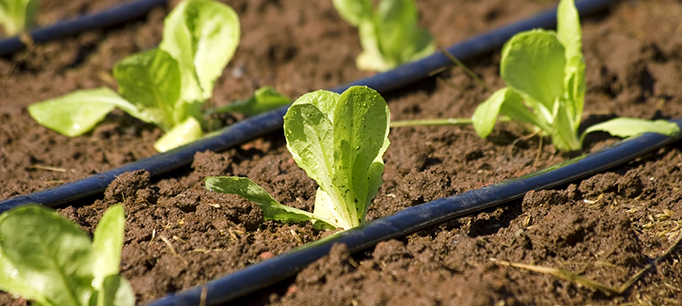The continuing drought is having a big ripple effect in California agriculture. We talked to David Zoldoske, the director of Fresno State’s Center for Irrigation Technology (CIT) and a member of the Water Policy Center’s research network, about trends in farm water management.
PPIC: How well is California agriculture doing in terms of water efficiency in recent years?
 David Zoldoske: The big change is that the state’s growers are investing heavily in drip and micro-irrigation systems, and very soon there will be more acreage using these efficient systems than flood or furrow irrigation. Part of the increase comes from growers converting annual crops to trees and vines, and installing micro irrigation systems. So while we’ve gotten more efficient in irrigating these acres, we’ve also hardened demand for water—and in some cases increased overall water demand—because these perennial crops can’t be fallowed in times of drought. But there’s no doubt that this is a paradigm change, and it’s making California agriculture more efficient in its overall on-farm water use.
David Zoldoske: The big change is that the state’s growers are investing heavily in drip and micro-irrigation systems, and very soon there will be more acreage using these efficient systems than flood or furrow irrigation. Part of the increase comes from growers converting annual crops to trees and vines, and installing micro irrigation systems. So while we’ve gotten more efficient in irrigating these acres, we’ve also hardened demand for water—and in some cases increased overall water demand—because these perennial crops can’t be fallowed in times of drought. But there’s no doubt that this is a paradigm change, and it’s making California agriculture more efficient in its overall on-farm water use.
PPIC: What successful water-management technologies are California farmers already using that deserve wider adoption?
DZ: Tools such as water meters for measuring flow rates from pumps and soil moisture sensors are both important to improve water management. Scheduling for efficiency means knowing how much water you’re applying (the meters), and how deep it’s going (the sensors). Flow meters also help growers see real-time changes in how much water they’re using—if flow rates decrease, it could indicate a drop in groundwater levels, a worn pump, or perhaps a clogged filter. Without metering, it’s like driving a car without a speedometer or odometer. We’ve estimated that only about a third of groundwater pumps have flow meters installed, so there’s lots of room for wider adoption of this important technology. Water meters can provide important information both on-farm (how efficiently is the irrigation system performing and how much water was applied), as well as a measuring groundwater basin withdrawals.
PPIC: What’s the potential for high tech improvements to take farm-water efficiency to the next level?
DZ: Managing water on a large irrigated farm is both an art and a science, with multiple data points to consider. Many growers are operating with too little information, while others may be experiencing data overload from all the technology inputs. New cloud-based technologies can help farmers get more data, in real time, and allow them to better manage their crop water needs. But it’s important to remember that even with improved technologies on the farm, you can’t efficiently manage a poorly operating system. Often it’s the low tech approaches that provide the most benefits—like getting your pump tested, having your irrigation system audited for uniformity, and improving scheduling. Farmers need to get better at these basic technologies before the high tech improvements can really work. There is a tremendous opportunity for the state to help incentivize the adoption of key technologies like water meters to improve water efficiency across a broad spectrum of irrigated land. California should be strategic when it provides financial assistance for adopting new water technologies.
PPIC: Are there “unintended consequences” to agriculture becoming more efficient?
DZ: As we convert more acres from flood or surface irrigation to higher efficiency drip systems, we need to be aware that we may be losing potential recharge for our groundwater basins. Excess water applied to a field is an important source—and in some places the primary source—of recharge. Improving water efficiency on any one farm can directly affect the groundwater supply of a nearby farm or municipality. California must aggressively address the need for more groundwater recharge as an offset for more efficient farm water use.
PPIC: What long-term improvements to agricultural water management do you think will come out of this drought?
DZ: The biggest change will be the understanding that we need to manage groundwater basins for sustainability. It will likely cause some financial pain and suffering, but it will also help us avoid a “tragedy of the commons” situation, where everyone loses as groundwater basins are exhausted. Right now, we have too many big straws in the aquifer, and we have to start managing for the long view. I also believe we’ll be making more use of non-traditional sources of water, such as the large amounts of saline groundwater found in parts of the Central Valley. We are also evaluating the potential of diverting excess floodwaters to cropland with high infiltration rates, to help recharge groundwater basins during wet years. And most likely in future, we’ll be farming less ground in California, but getting “more crop per drop” by using water more efficiently.
Read more: Water for Farms from our California’s Water briefing kit


